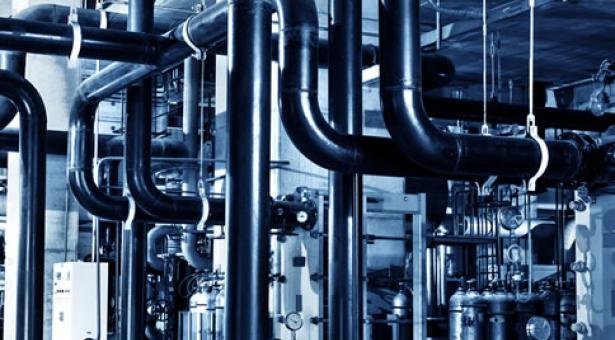

primary coolant loop

The primary coolant loop is a closed-cycle system surrounding the reactor chamber that uses pressurised water to transfer thermal energy away from the reactor to the heat exchange. This process protects reactor chamber components by keeping their temperature within a manageable range.
 The primary coolant loop is comprised of several hundred meters of high density tungsten-nickel-copper metal alloy tubing which forms a tight sphere around the reactor tokamak, between the dual-layers of the tokamak wall. Although the use of high density of tungsten alloys (18.8 g/cm3) raises orbital construction difficulties, the material’s low magnetic permeability, low rate of thermal expansion and high thermal conductivity make it ideal for this application. Given the coolant loop's proximity to the reactor's magnetic containment field, any lighter-weight ferrous material would be unsuitable as it may interfere with containment field dynamics.
The primary coolant loop is comprised of several hundred meters of high density tungsten-nickel-copper metal alloy tubing which forms a tight sphere around the reactor tokamak, between the dual-layers of the tokamak wall. Although the use of high density of tungsten alloys (18.8 g/cm3) raises orbital construction difficulties, the material’s low magnetic permeability, low rate of thermal expansion and high thermal conductivity make it ideal for this application. Given the coolant loop's proximity to the reactor's magnetic containment field, any lighter-weight ferrous material would be unsuitable as it may interfere with containment field dynamics.
During normal operation the thermal energy of the reaction is used to heat and pressurise the primary coolant loop and subsequently drive the system’s turbines. In addition, kinetic energy from particles escaping the reaction is converted into heat when they strike and penetrate the reaction isolation shield. As all thermal energy collects at the shield layer, the continual flow of coolant through the primary coolant loop is essential for nominal reactor operation. Failure of the coolant loop to continually convect heat away from a section of the reactor shield layer may cause unscheduled and early shielding failure, exposing the tokamak wall to excessive levels of neutron radiation or other fusion products.
The thermal transfer medium is pressurised water. Other media (such as liquid sodium) have been found to be more efficient for this purpose but are potentially highly dangerous in military environments where there is a significant high risk of damage. In addition, water is expected to be significantly easier to replace during operations in deep space, should this become necessary.
system operation
pumpset
The water inside the primary loop is pressurised to increase the temperature at which boiling occurs. This increases the heat transfer capacity of the loop. Heat transfer is significantly more efficient when the thermal transfer medium is in a liquid rather than gaseous state.
A heavily redundant pumpset is responsible for pressurising and circulating the water in the primary loop. The primary pumpset is made up of two identical pumps, each with the capacity to individually pressurise the loop but operating at half capacity (so that one can immediately take up the load if the other should fail).
An identical auxiliary pumpset activates automatically if there is a failure with the primary pumpset.
coolant system temperature
The primary coolant system must be maintained within a temperature range to ensure optimal heat transfer and prevent pressurisation beyond the system's rated capacity.
The temperature of the water in the primary coolant loop is primarily influenced by the reaction temperature at the reactor chamber wall. There are two main variables affecting temperature within the coolant loop:
coolant loop pressure
The water must be pressurised at a level appropriate to the temperature load to prevent boiling, while remaining within the coolant loop's design parameters for pressure. Coolant loop pressure is controlled by pressure pumpsets.
Emergency vent valves will release steam should water in the primary loop begin to boil. Additional water is stored in reserve to replace water lost from the loop in this way or through leaks.
Changes to coolant loop pressure have no significant impact on the temperature of coolant loop water, only the temperature at which the water will boil. As the temperature of the water itself increases there is a slight increase in overall pressure (assuming the same level of flow control) but this is not operationally significant.
coolant loop flow
Increasing the flow of water through the coolant loop reduces the amount of heat absorbed, which will decrease the temperature of the water in the coolant loop. As this will also decrease the temperature load the coolant loop can accept from the reaction chamber, an optimal flow rate for thermal absorption (nominal flow rate) should be maintained. Increasing flow rate above nominal may be adopted where a rapid reduction in coolant loop temperature is needed, for example.
Flow is controlled by increasing pump output.
engineering events
sub-optimal heat transfer impact
If heat transfer is mismanaged, there are a number of potential impacts on the reaction process:
insufficient heat transferred to coolant loop
The less heat transferred to the coolant loop, the less will be transferred to the heat exchange which will reduce steam generation. A reduction in steam generation will reduce pressure in the secondary coolant loop, reducing the turbine’s ability to maintain RPM's and impacting power generation.
too much heat transferred to the coolant loop
If the heat that is transferred to the primary coolant loop is too much for the coolant loop's pressure/flow parameters, the water inside the loop will boil, creating a large increase in pressure. This pressure will quickly need to be released by automatic safety valves to prevent damage to the loop. The use of the safety valves will be in combination with a large injection of cold water into the loop, to compensate for the drop in pressure which will produce additional boiling and to ensure that the active cooling required by key reactor components such as the divertor remains adequate.
The impact of this process is not easily controllable, with the most likely outcome that the temperature of the coolant loop will drop well below normal parameters, adversely impacting power generation (see above) until the loop can be stabilised.








